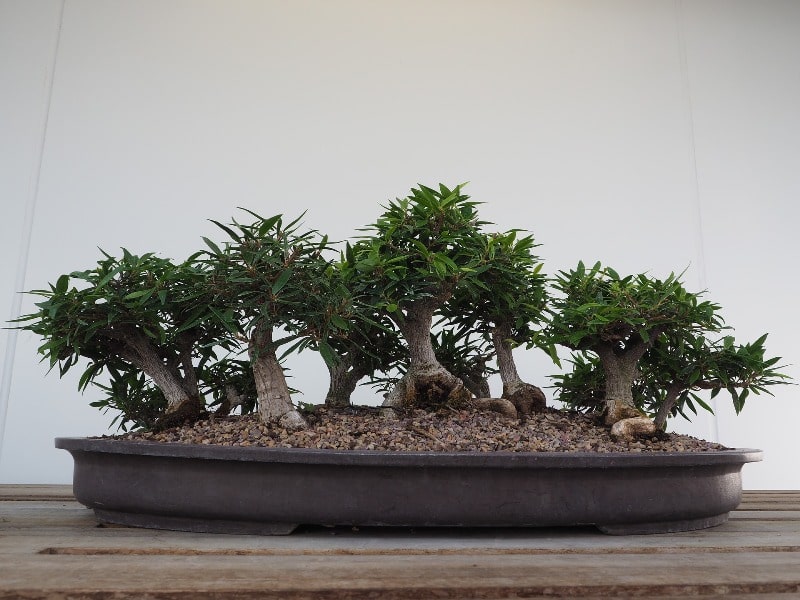It is fairly hard to keep tropical plants thriving indoors during the winter in north regions. Today we are going to talk about Indoor Bonsai

Because our winters are so dark, and our houses are generally very dry, extra steps must be taken to maintain our little corners of Eden indoors.
We need to duplicate the lighting requirements for our plants according to what they normally live in.
Most plants like about 10-16 hours of daylight. A formula for distance from light: energy decreases with the square of the distance from the light source.
A plant 1 foot from the light source receives 4 times the light energy that one two feet from the light will get. If this is too complicated, remember my own homegrown rule–closer is better.
Resist the temptation to leave the lights on 24 hours a day. NO plant wants constant light without a little down time everyday.
Light for indoor bonsai
Full spectrum lights are excellent, but rather expensive. Grow lights are very expensive, and they seem to not cover the entire spectrum range, so plants will not grow as much with only those lights.
A cheaper alternative is the placement of a cool and a warm fluorescent light. This will cover the entire spectrum necessary. If you buy a normal shop light, you can put in one warm and one cool light in each slot and you will have everything you will need in the one fixture.
If you wish to use spotlights, those will work, but if they are ceiling mounted, there will be a large distance from the trees, and much of the benefit of having extra light may be lost.
A gooseneck lamp on a table top may be enough if you are only focusing on one small tree.
Metal Halide lights
Metal Halide lights are wonderful, but they use a lot of energy, so the electric bill goes up. These lights will also sometimes burn the trees if they are too close to them, and they really need to be set up out of the living area.
Metal Halide lights duplicate the sun’s rays, so growth is great, but it can be unhealthy in areas of heavy use, as the light is too intense for prolonged exposure to our eyes and skin.
If everyone at home wishes to go about bundled up and wearing “Joe Cool” sunglasses in the house, this would be the ideal set-up for your place. If not, perhaps an extra area in a mostly unused room would be best.
One thing to remember is that the lights add a lot of warmth to their immediate area.
A place for the indoor bonsai
When I first started keeping bonsai, my wife allowed me to set up an environment in the closet of an unused bedroom downstairs.
I painted the interior a bright white attached four foot shop lights to the undersides of three sets of shelves across the entire closet, painted the back of the folding doors white, installed a small fan and let the plants grow. They enjoyed it immensely.
Later, I got a bigger light and moved out into the bedroom. I think I may set up the closet again and close those closet doors. The Ficus I had thrived incredibly well in there. I think the humidity and closeness of all that white paint suited them nicely.
Humidity and closeness
Plants prefer a somewhat humid environment, so a pebble tray is beneficial. A really easy way to make a pebble tray is to place one to two inches of pebbles in a waterproof tray under the plants.
Do not let the plants sit in the pebbles, or they may absorb too much moisture. I read of one helpful hint that suggested putting one of those grates used in commercial ceiling lights over the top of the pebbles to raise the plants above the moisture.
Seems like a great idea. If you just set the pot on top of the pebbles, it works as long as the holes are not so low that they are going to absorb water.
Slats set over the top of the tray will also work to raise the plant above the pebbles.
Enviromental temperature for an indoor bonsai
A temperature of about 60-65 is ideal, but plants will easily survive in the 40’s-50’s although there will be little growth.
Every plant has some type of a dormant season, be it only a few weeks long. A slightly lower temperature and a little less light will help the plants achieve their needed rest.
When it is time to get new growth and flowers, crank up the lights, raise the temperature, and get ready. If you are going to fertilize, be sure to wait until new growth has started before feeding the tree.

Risks and problems
High temperatures and humidity are a breeding ground for mold and mildew. Too much humidity can damage houses, so it is best to have a fan blowing in an area if it is set up as a plant room.
A small clip-on fan or a small floor fan set on a timer will work well. The trees find the wind beneficial, as the constant motion helps strengthen the branches, and the air flow keeps the walls from getting slimy.
It would be best to mention in passing the over-wintering of temperate trees (the trees and plants that will not live through an arctic winter, but are not classified as tropical either).
For those trees that are temperate, an area with temperatures between 35 and 40 degrees must be maintained for at minimum of 6-8 weeks. If you have such an area, be sure the lights in it are not kept on, because the light will trigger growth, even when the temperatures are rather cold.
This is often the case in root cellars and cold frames where things will grow and leaf out weakly in the cold, just because a 40 watt bulb was left on ‘to maintain heat’.
When you see real daylight is a good time for you to increase the artificial light, unless your aim is to maintain a totally artificial environment, at which case, the lights will help to develop leaves for the lushness of that environment whenever you please.
Remember though, these temperate trees need a period of dormancy to stay alive. A year or two of forced, accelerated growth will weaken the tree—much like what would happen to you if you were sleep deprived for an extended period of time.
Some helpful books that include types of plants that do well indoors and clear tips on how to help them thrive are:
- Indoor Bonsai by Brooklyn Botanical Gardens
- Ficus the Exotic Bonsai by Jerry Meislik
